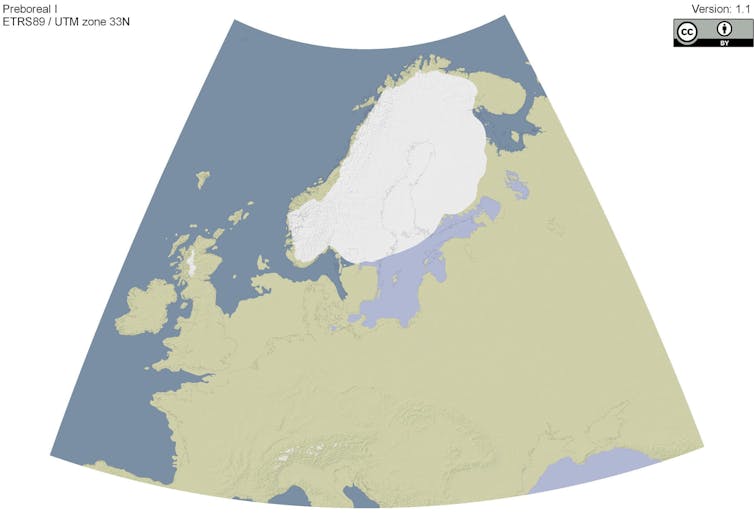Archaeologists have identified what may be Europe’s oldest human-made megastructure, submerged 21 metres below the Baltic Sea in the Bay of Mecklenburg, Germany. This structure – which has been named the Blinkerwall – is a continuous low wall made from over 1,500 granite stones that runs for almost a kilometre. The evidence suggests it was constructed by Palaeolithic people between 11,700 and 9,900 years ago, probably as an aid for hunting reindeer.
The archaeologists investigating the Bay of Mecklenburg used a range of submarine equipment, sampling methods and modelling techniques to reconstruct the ancient lake bed and its surrounding landscape. This revealed that the Blinkerwall stands on a ridge running east to west, with a 5km-wide lake basin a few metres below the ridge to the south.
The human, rather than natural, origin for the Blinkerwall was confirmed by an archaeological diving team who photographed sections of the wall. These show that it is made up of 288 very large boulders, which were probably dropped in that location by the retreating glacier, connected by 1,673 smaller stones.
These smaller stones appear to have been collected from the immediate vicinity, as the area just to the north of the wall has many fewer stones than the areas even further north. The resulting structure stands a little under a metre in height and up to two metres wide, with remarkable regularity over its 971-metre length.
A different landscape
At the time of its construction, the landscapes and seascapes of northwest Europe were very different from today. The climate was beginning to warm as the colder Pleistocene era ended and the warmer Holocene era began. Sea levels were much lower, and large glaciers sat over much of Fennoscandia.
The land around the Baltic Sea basin was rising rapidly, released from the weight of the retreating glaciers and transforming a brackish body of water known as the Yoldia sea into the freshwater Ancylus lake. Great Britain was a peninsula of the European continental landmass, with a vast lowland plain known as Doggerland stretching from Norfolk to the Netherlands. Herds of reindeer, European bison and wild horse migrated across its sparsely forested landscape.
In cultural terms, this period, known as the Late Upper Palaeolithic, is marked by significant hallmarks in technological innovation by the people who lived at this time. Dogs had been recently domesticated; there are regionally distinct forms of stone projectile points; and there is frequent use of decorated bone and antler harpoons, as well as specialist hunting strategies employed to target migrating prey.
The identification of the Blinkerwall now demonstrates that Palaeolithic hunters were managing their landscape to aid their hunting activities more deliberately than was previously thought.
P. Hoy, University of Rostock, model created using Agisoft Metashape: J. Auer, LAKD M-V, Author provided (no reuse)
Construction of walls and other features in the landscape is familiar to us, particularly in the context of land enclosure for farming. Both contemporary and ancient societies that have traditionally subsisted by hunting and gathering wild resources are also known to alter their environments by constructing features such as stone walls. These are used for a variety of purposes including fishing, shellfishing and hunting.
The researchers compared the Blinkerwall to other archaeologically documented structures of a similar length and construction type that have been identified in the Middle East, North America, Canada and Greenland. These structures are interpreted as having been built for the purpose of game drive hunting. In this strategy, hunters use landscape and built features to gain an advantage over their prey by directing its movements to a location where they are more vulnerable to attack by other hunters.
The similarity of the Blinkerwall to these other structures, and its construction adjacent to a body of water, led to the suggestion that the wall had been created for the same purpose. The lake itself may also have been used in this strategy.
Supporting evidence
One archaeological site from Germany that supports this interpretation is Stellmoor, located just north of Hamburg and which dates to the latest time that the Blinkerwall could have been constructed.
The site is located at the end of a narrow valley where thousands of reindeer bones – some bearing hunting impact traces, flint points and even pinewood arrow shafts – were found preserved in the ancient lake sediments. The hunting evidence at Stellmoor shows the reindeer were shot by arrows as they were driven down the valley into the lake.

Centre for Baltic and Scandinavian Archaeology (ZBSA), CC BY
While there is no archaeological evidence at Stellmoor to suggest people had deliberately created or changed the landscape to enhance their hunting success, it shows how the topography of the landscape was used to the hunters’ advantage. The Blinkerwall construction provides evidence that Palaeolithic people took this level of planning and coordination a step further.
It shows they recognised and understood the instincts of their prey so well that they were able to predict their movements – and how they would react when faced with an artificially created obstacle like the Blinkerwall.
The discovery of this monumental piece of hunting architecture is unique in Europe. At a maximum of 11,700 years old, it is one of the oldest examples in the world, potentially predating a desert hunting “kite” at Jibal al-Gadiwiyt in Jordan by over a thousand years.
The Blinkerwall adds a new element to our understanding of the highly skilled and specialised hunting strategies engineered by people at the end of the last glacial period – strategies that have continued to be used in different landscapes for millennia. And the discoveries are unlikely to stop here.
The Bay of Mecklenburg has the potential to reveal further archaeological evidence of equal significance. The researchers do not rule out the possibility that another wall or other associated features could be found, buried under later sedimentation of the ancient lake.
If weapons, tools or animal remains were to be recovered at the site, this would reveal information about the nature and duration of its use – and far greater insights into the sophisticated subsistence strategies of the Palaeolithic hunters of the Baltic.



